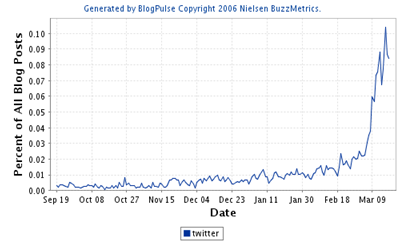Follow-Up on WGI’s Internal Blogging
It was almost one year ago that Shel Israel met with Andy Snodgrass to talk about internal blogging at WGI.
I had the opportunity to meet Andy and I had to ask him if anything had become of his interest in internal blogging. I was disappointed but not at all surprised to hear that nothing at all had come of it. It seemed apparent from his response that the idea was not even on the table anymore.
WGI like most companies in America are faced with an uncertain future. There is going to be a huge loss in resources and knowledge as Baby Boomers leave the workplace. There just are not as many Gen Xers (about half) to fill the vacancy’s that are coming and Gen Y is mostly too green to take on higher management role.
Andy admitted that social networking tools would be a perfect fit to solve their problems. He also brought up one of the best arguments as to why they dropped the idea: Baby Boomers won’t use the tools. Now my first gut reaction was: there are Baby Boomers who blog, followed by, if you implemented the tools, provided training and instituted a policy…. Then reality set in, yeah they wouldn’t use it. Most Baby Boomers are not going to use any type of social networking tool.
WGI has a good plan in place: As their engineers move into retirement, hire them back part time and team them up with someone they can mentor. A good majority of these Type A engineers would love an opportunity like this.
Then I thought a little more seriously about their problem. How do they pass on all of that valuable information from their aging engineers to the younger, just out of school engineers? One on one is great and invaluable, but how much information can be passed on and retained this way. WGI’s plan won’t work for each new hire. Even if they could get a one to one match up across the company you have personality differences and generational dynamics that won’t work in all cases. Plus how long will Baby Boomers really want to work or be able to?
Gen Y and a certain percentage of Gen X would willingly use new media tools. Combine those tools with the steps that WGI is already implementing and you have a real Enterprise 2.0 Knowledge Management solution. As the younger engineers learn from their mentors they can record and share that information with their peers. Blogs, podcasts, wikis, tagging, RSS feeds and all things geeky could make information sharing across the entire company infinitely more powerful than any currently available enterprise solution.
Obviously no solution is utopian, and there would still be many more hurdles to implementing a solution like this but it seems better than anything else I’ve heard of. Does anyone know of a company using new media for this type of solution? Can someone think of a better solution?
Additional Resources:
All Kind Food
Andrew McAfee
If you enjoyed this post, make sure you subscribe to my RSS feed!



